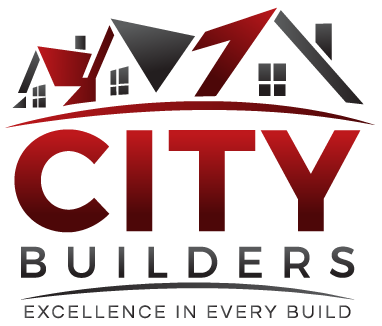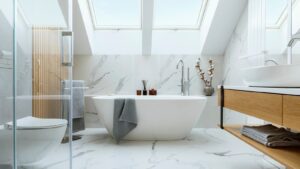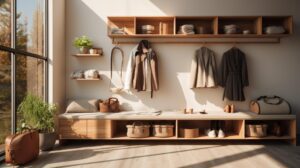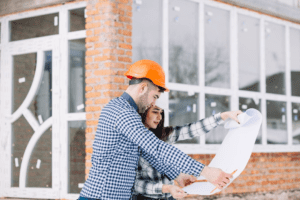As we age, our needs and lifestyle change, and our homes should adapt accordingly. Designing a home that allows you to age in place comfortably means incorporating features that make daily living safer, more accessible, and convenient. Whether you’re building a new home or planning a renovation, here are key features to consider to make your space age-friendly, ensuring that you can continue to enjoy your home for years to come.
1. Single-Level Living
One of the most crucial design considerations for aging in place is creating a single-level living environment. Having all essential spaces, such as the bedroom, bathroom, kitchen, and laundry, on one floor can make your home much more manageable as mobility becomes a concern. A single-level design reduces the need for stairs, which can become a major safety hazard as we age.
2. Wider Doorways and Hallways
Wider doorways and hallways make it easier for those who use mobility aids like walkers or wheelchairs to move around freely. Aim for doorways that are at least 36 inches wide and hallways that are 42 inches or more. This not only enhances accessibility but also makes your home feel more spacious. Additionally, consider installing lever-style handles instead of traditional doorknobs, as they are easier to use for those with arthritis or limited hand strength.
3. Step-Free Entryways
Ensure that at least one entryway to your home is step-free to allow easy access, whether you’re using a wheelchair or simply want to avoid tripping hazards. A ramped entry or a zero-step threshold is ideal for making your home accessible for everyone, from young children to seniors. This step-free access should extend to your back door or outdoor living area as well.
4. Accessible Bathroom Design
Bathrooms can be challenging as we age, but a few design adjustments can make a big difference. Consider installing a curbless shower for easy access, grab bars near the toilet and in the shower for added stability, and a comfort-height toilet that is easier to sit down on and stand up from. Including a fold-down shower seat can also make bathing safer and more comfortable. To enhance safety, choose slip-resistant flooring to prevent falls.
5. Kitchen with Accessibility Features
An age-friendly kitchen should be designed for convenience and accessibility. Include features like pull-out shelves in lower cabinets to reduce bending, easy-to-reach drawers, and lever-style faucet handles that are simpler to operate. Wall ovens installed at waist height and cooktops with front controls are other considerations that make cooking easier and safer. Ample lighting, including task lighting under cabinets, is also crucial for visibility.
6. Non-Slip Flooring
Slip-and-fall accidents are a leading cause of injury for older adults, so selecting the right flooring is essential. Choose non-slip surfaces for areas like the bathroom, kitchen, and entryways. Vinyl, cork, and textured tile are good options that provide traction while still being comfortable underfoot. Area rugs should be avoided or secured with non-slip pads to prevent tripping hazards.
7. Smart Home Features
Integrating smart home technology can add convenience and safety as you age. Consider features like smart lighting that can be voice-activated, video doorbells to see who is at the door without needing to get up, and thermostats that can be controlled remotely. Smart locks that work via smartphone or keypad can also eliminate the need to fumble with keys, making daily tasks more manageable.
8. Comfortable and Adjustable Lighting
Good lighting is essential for safety as well as comfort. As our eyesight diminishes with age, ensuring that your home has sufficient, adjustable lighting becomes even more important. Include task lighting in work areas such as the kitchen, bathroom, and office, as well as motion-activated night lights in hallways and bedrooms to prevent falls during the night. Dimmers can also help adjust the light intensity to reduce glare and create a comfortable environment.
9. Easy-Access Storage Solutions
Design storage solutions that require minimal bending or reaching. Lower cabinets with pull-out trays, closets with adjustable rods, and drawer organizers can make accessing stored items easier. Avoid installing cabinets that require a step stool to reach frequently used items. Having storage that is easily accessible reduces the risk of falls and strain.
10. Bedroom Comfort and Safety
Make your bedroom comfortable and accessible by considering features like a bed at an appropriate height to easily get in and out, light switches near the bed, and clear pathways without tripping hazards. Placing a chair with armrests nearby provides a convenient seating option for dressing or putting on shoes.
Conclusion
Designing a home to age in place ensures that your space remains comfortable, safe, and convenient as your needs change. By incorporating features like wider doorways, step-free entryways, accessible bathrooms, and smart home technology, you can create a home that adapts to you rather than the other way around.
Ready to start designing your forever home? Contact Us Today to Start Your Dream Project—let’s build a space that will support you for a lifetime!







